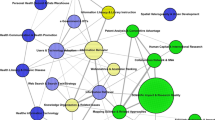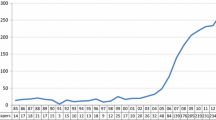Abstract
The aim of this study is to map the intellectual structure of digital library (DL) field in China during the period of 2002–2011. Co-word analysis was employed to reveal the patterns of DL field in China through measuring the association strength of keywords in relevant journals. Data was collected from Chinese Journal Full-Text Database during the period of 2002–2011. And then, the co-occurrence matrix of keywords was analyzed by the methods of multivariate statistical analysis and social network analysis. The results mainly include five parts: seven clusters of keywords, a two-dimensional map, the density and centrality of clusters, a strategic diagram, and a relation network. The results show that there are some hot research topics and marginal topics in DL field in China, but the research topics are relatively decentralized compared with the international studies.





Similar content being viewed by others
References
Callon, M., Courtial, J. P., & Laville, F. (1991). Co-word analysis as a tool for describing the network of interactions between basic and technological research: The case of polymer chemistry. Scientometrics, 22(1), 155–205.
Callon, M., Courtial, J. P., Turner, W. A., & Bauin, S. (1983). From translations to problematic networks: An introduction to co-word analysis. Social Science Information, 22(2), 191–235.
Cambrosio, A., Limoges, C., Courtial, J. P., & Laville, F. (1993). Historical scientometrics? Mapping over 70 years of biological safety research with co-word analysis. Scientometrics, 27(2), 119–143.
Coulter, N., Monarch, I., & Konda, S. (1998). Software engineering as seen through its research literature: A study in co-word analysis. Journal of the American Society for Information Science, 49(13), 1206–1223.
Ding, X. (2010). Research on the book intelligent recommendation system based on data mining. Information Studies: Theory & Application (in China), 33(5), 107–110.
Ding, Y., Chowdhury, G., & Foo, S. (2001). Bibliometric cartography of information retrieval research by using co-word analysis. Information Processing and Management, 37(6), 817–842.
Dong, W. (2009). Analysis on hotspot of digital library in home during 10 years based on co-word analysis. Document Information & Knowledge., 5, 58–63.
Gao, Z. Y. (2008). Digital library development trend under the ubiquitous knowledge environment. Journal of Information (in China), 2, 156–158.
Gao, G. X., & Liu, B. (2011). Analyses on the authors in the articles of digital library in China. Information Science (in China), 29(5), 723–726.
Law, J., Bauin, S., Courtial, J. P., & Whittaker, J. (1988). Policy and the mapping of scientific change: A co-word analysis of research into environmental acidification. Scientometrics, 14(3), 251–264.
Lee, W. H. (2008). How to identify emerging research fields using scientometrics: An example in the field of information security. Scientometrics, 76(3), 503–525.
Li, Y. C. (2009). Statistic analysis of papers on digital libraries in China. Journal of Library and Information Sciences in Agriculture (in China), 21(1), 62–64.
Li, J. & Dong, Q. (2009). Research of SAN and NAS storage technology in the digital library. Journal of Modern Information (in China), 29(9), 101–103,120.
Liu, C. S., & Zhang, X. J. (2011). Statistic analysis of the papers on digital libraries. Journal of Modern Information (in China), 31(3), 113–116.
Qiu, J. P., & Ma, F. (2010). Study on Chinese digital library research papers. Library and Information Service (in China), 54(17), 27–31.
Qiu, J. P., & Wang, M. Z. (2010). The analysis of the digital library research paper in China from the years of 1999 to 2008. Journal of Intelligence (in China), 29(2), 1–5.
Shen, L. Z. (2010). Applied research of hierarchical storage of digital library based on information lifecycle management. Library Journal (in China), 29(6), 48–52.
Small, H. (1973). Co-citation in the scientific literature: A new measure of the relationship between two documents. Journal of the American Society for Information Science, 24(4), 265–269.
Small, H., & Griffith, B. C. (1974). The structure of scientific literatures I: Identifying and graphing specialties. Science Studies, 4(1), 17–40.
Su, N. (2009). Analysis of subjects and development in digital libraries research based on co-words analysis method. Journal of Intelligence (in China), 28(6), 15–19.
Van Eck, N. J., & Waltman, L. (2009). How to normalize cooccurrence data? An analysis of some well-known similarity measures. Journal of the American Society for Information Science and Technology, 60(8), 1635–1651.
Wang, W. Q., & Chen, L. (2009). The model of CALIS cloud service platform for distributed digital libraries. Journal of Academic Libraries (in China), 4, 13–18.
Wang, L. Y., Zhang, Z. Q., & Wei, J. Z. (2011). A study on foreign research subjects of library and information science based on the co-word analysis during the last ten years. Journal of intelligence (in China), 30(3), 50–58.
Wei, W.J., & Wei, H.Y. (2011). The analysis of hot topics on digital library research by citespace II. Library Journal (in China), 30(4), 70–76, 88.
Wu, B. (2008). Digital library = digitalized knowledge system + information technology. Journal of the National Library of China (in China), 3, 23–27.
Xu, X. M., & Niu, Z. D. (2007). Study on the knowledge organization at digital libraries. New Technology of Library and Information Service (in China), 10, 1–6.
Zhang, X., & Lv, Y. J. (2010). Research overview on development of digital library in China in the past five years. Researches in Library Science (in China), 2, 18–22.
Zhao, J. H. (2006). Institutional repository: New field in the development of digital libraries. The Journal of the Library Science in China (in China), 32(2), 33–36.
Acknowledgments
This study is supported by the project of National Social Science Foundation of China (No. 09CTQ020) and the project of National Social Science Foundation of China (No. 11CTQ006).
Author information
Authors and Affiliations
Corresponding author
Rights and permissions
About this article
Cite this article
Liu, GY., Hu, JM. & Wang, HL. A co-word analysis of digital library field in China. Scientometrics 91, 203–217 (2012). https://doi.org/10.1007/s11192-011-0586-4
Received:
Published:
Issue Date:
DOI: https://doi.org/10.1007/s11192-011-0586-4




